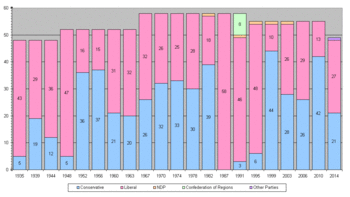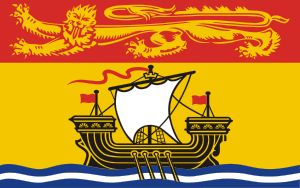List of post-confederation New Brunswick general elections

| Conservative | Liberal | NDP |
| Confederation of Regions | Other Parties |
This article provides a summary of results for the general elections to the Canadian province of New Brunswick's unicameral legislative body, the Legislative Assembly of New Brunswick. Prior to 1892, New Brunswick had a bicameral legislature, but its Upper House – the Legislative Council – was not elected. The number of seats has varied over time – from 41 at the time of Canadian Confederation, to a high of fifty-eight from 1967 through 1991, to the current level of 55 since the 1995 election.
Beginning with the 37th New Brunswick general election in 2010, elections in New Brunswick are – in general – held on fixed dates on the fourth Monday of September every four years. The date may be varied by one week earlier or later in cases of the fourth Monday of September being a date of cultural or religious significance and may be varied one month earlier or later in cases of a federal election being held during the same period. The Lieutenant-Governor of New Brunswick also has the power to call an election on another date in the event of a loss of confidence in the legislature.[1]
The chart on the upper right shows the information graphically, with the most recent elections towards the right. It shows that New Brunswick has effectively a two-party system – the Liberals (red) and the Conservatives (blue); along with the one-off success of the Confederation of Regions party (green) in 1991. It also shows the Liberal party's clean sweep of seats in 1987, one of the few instances in history when a party won all the seats in a national or sub-national legislature. Since provincial parties were officially recognised, the Liberal party have won eleven out of twenty elections.

This article only covers elections since the province became part of the Canadian Confederation in 1867. Prior to becoming part of Canada, New Brunswick was a British colony; and the New Brunswick House of Assembly was first formed in 1784 – when New Brunswick separated from Nova Scotia.
1935–present
Between 1935 and 1974, some ridings were multi member seats – i.e., more than one Member of the Legislative Assembly was elected from certain ridings. Political parties were officially recognized and registered beginning in 1935. Since 1974, each riding (electoral district) has elected only one member to the Legislative Assembly of New Brunswick.
| Election | Total seats |
Conservative[A] | Liberal | NDP | Other Parties | |||
|---|---|---|---|---|---|---|---|---|
| 18th | June 27, 1935 | 48 | 5 | 43 | ||||
| 19th | November 20, 1939 | 48 | 19 | 29 | ||||
| 20th | August 28, 1944 | 48 | 12 | 36 | ||||
| 21st | June 28, 1948 | 52 | 5 | 47 | ||||
| 22nd | September 22, 1952 | 52 | 36 | 16 | ||||
| 23rd | June 18, 1956 | 52 | 37 | 15 | ||||
| 24th | June 27, 1960 | 52 | 21 | 31 | ||||
| 25th | April 22, 1963 | 52 | 20 | 32 | ||||
| 26th | October 13, 1967 | 58 | 26 | 32 | ||||
| 27th | October 26, 1970 | 58 | 32 | 26 | ||||
| 28th | November 18, 1974 | 58 | 33 | 25 | ||||
| 29th | October 23, 1978 | 58 | 30 | 28 | ||||
| 30th | October 12, 1982 | 58 | 39 | 18 | 1 | |||
| 31st | October 13, 1987 | 58 | 0 | 58 | ||||
| 32nd | September 23, 1991 | 58 | 3 | 46 | 1 | 8 (Confederation of Regions[B]) | ||
| 33rd | September 11, 1995 | 55 | 6 | 48 | 1 | |||
| 34th | June 7, 1999 | 55 | 44 | 10 | 1 | |||
| 35th | June 9, 2003 | 55 | 28 | 26 | 1 | |||
| 36th | September 18, 2006 | 55 | 26 | 29 | ||||
| 37th | September 27, 2010 | 55 | 42 | 13 | ||||
| 38th | September 22, 2014 | 49 | 21 | 27 | 1 (Green Party) | |||
Notes
- A Includes results for Progressive Conservatives.
- B The Confederation of Regions Party only contested the 1991, 1995 and 1999 elections.
1866–1934
New Brunswick joined the Canadian confederation in 1867. Party labels were not used so it is not plausible to use tables as above. Between 1917 and 1935, party lines had developed, but were not recognized by electoral law. The results are listed below. Before this, only "Government" and "Opposition" were used.
| Election | Total Seats |
Standings | |||
|---|---|---|---|---|---|
| 1st | May–June, 1866 | 41 | Government 33 (Confederationalist) |
Opposition 8 (Constitutionalist) |
|
| 2nd | June–July, 1870 | 41 | Government 24 | Opposition 16 | Neutral 1 |
| 3rd | May–June, 1874 | 41 | Government 35 | Opposition 5 | Neutral 1 |
| 4th | June, 1878 | 41 | Government 31 | Opposition 10 | |
| 5th | June, 1882 | 41 | Government 22 | Opposition 18 | Neutral 1 |
| 6th | April 26, 1886 | 41 | Government 33 (Liberal) |
Opposition 8 (Conservative) |
|
| 7th | January 20, 1890 | 41 | Government 26 (Liberal) |
Opposition 15 (Conservative) |
|
| 8th | October, 1892 | 41 | Government 25 (Liberal) |
Opposition 12 (Conservative) |
Neutral 4 |
| 9th | October, 1895 | 46 | Government 34 (Liberal) |
Opposition 9 (Conservative) |
Neutral 3 |
| 10th | February 18, 1899 | 46 | Government 40 (Liberal) |
Opposition 4 (Conservative) |
Neutral 2 |
| 11th | February 28, 1903 | 46 | Government 33 (Liberal) |
Opposition 10 (Conservative) |
Neutral 3 |
| 12th | March 3, 1908 | 46 | Opposition 31 (Conservative) |
Government 12 (Liberal) |
Neutral 2 |
| 13th | June 20, 1912 | 48 | Government 44 (Conservative) |
Opposition 2 (Liberal) |
Neutral 2 |
| 14th | February 24, 1917 | 48 | Opposition 27 (Liberal) |
Government 21 (Conservative) |
|
| 15th | October 9, 1920 | 48 | Government 24 (Liberal) |
Opposition 13 (Conservative) |
Opposition (United Farmers) 9 Opposition (Farmer-Labour) 2 |
| 16th | August 10, 1925 | 48 | Opposition 37 (Conservative) |
Government 11 (Liberal) |
|
| 17th | June 19, 1930 | 48 | Government 31 (Conservative) |
Opposition 17 (Liberal) |
|
See also
- Timeline of Canadian elections
- General elections in New Brunswick (pre-Confederation)
- List of political parties in New Brunswick
References
Bibliography
- "New Brunswick Votes 2006". CBC.ca. Retrieved 2006-12-23. (results back to 1956)
- Doyle, Arthur T. (1984). Elections in New Brunswick, 1784-1984. Fredericton: Brunswick Press. ISBN 0-88838-391-6.
